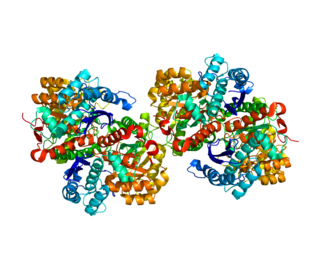L-myc-1 proto-oncogene protein is a protein that in humans is encoded by the MYCL1 gene. [5] [6]
Contents
MYCL1 is a bHLH (basic helix-loop-helix) transcription factor implicated in lung cancer. [7]
L-myc-1 proto-oncogene protein is a protein that in humans is encoded by the MYCL1 gene. [5] [6]
MYCL1 is a bHLH (basic helix-loop-helix) transcription factor implicated in lung cancer. [7]
Myc is a family of regulator genes and proto-oncogenes that code for transcription factors. The Myc family consists of three related human genes: c-myc (MYC), l-myc (MYCL), and n-myc (MYCN). c-myc was the first gene to be discovered in this family, due to homology with the viral gene v-myc.

Twist-related protein 1 (TWIST1) also known as class A basic helix–loop–helix protein 38 (bHLHa38) is a basic helix-loop-helix transcription factor that in humans is encoded by the TWIST1 gene.

N-myc proto-oncogene protein also known as N-Myc or basic helix-loop-helix protein 37 (bHLHe37), is a protein that in humans is encoded by the MYCN gene.

Enolase 1 (ENO1), more commonly known as alpha-enolase, is a glycolytic enzyme expressed in most tissues, one of the isozymes of enolase. Each isoenzyme is a homodimer composed of 2 alpha, 2 gamma, or 2 beta subunits, and functions as a glycolytic enzyme. Alpha-enolase, in addition, functions as a structural lens protein (tau-crystallin) in the monomeric form. Alternative splicing of this gene results in a shorter isoform that has been shown to bind to the c-myc promoter and function as a tumor suppressor. Several pseudogenes have been identified, including one on the long arm of chromosome 1. Alpha-enolase has also been identified as an autoantigen in Hashimoto encephalopathy.

MYC proto-oncogene, bHLH transcription factor is a protein that in humans is encoded by the MYC gene which is a member of the myc family of transcription factors. The protein contains basic helix-loop-helix (bHLH) structural motif.

DNA-binding protein inhibitor ID-1 is a protein that in humans is encoded by the ID1 gene.

NK2 homeobox 1 (NKX2-1), also known as thyroid transcription factor 1 (TTF-1), is a protein which in humans is encoded by the NKX2-1 gene.

Proto-oncogene serine/threonine-protein kinase Pim-1 is an enzyme that in humans is encoded by the PIM1 gene.

MAX is a gene that in humans encodes the MAX transcription factor.

Transcription factor E3 is a protein that in humans is encoded by the TFE3 gene.

MAX-interacting protein 1 is a protein that in humans is encoded by the MXI1 gene.

MAD protein is a protein that in humans is encoded by the MXD1 gene.

Zinc finger MYND domain-containing protein 10 is a protein that in humans is encoded by the ZMYND10 gene.

Integrator complex subunit 6 is a protein that in humans is encoded by the INTS6 gene.

MNT is a Max-binding protein that is encoded by the MNT gene

Ribosomal oxygenase 2 is a protein that in humans is encoded by the RIOX2 gene.

Metadherin, also known as protein LYRIC or astrocyte elevated gene-1 protein (AEG-1) is a protein that in humans is encoded by the MTDH gene.

Protein CIP2A also known as cancerous inhibitor of PP2A (CIP2A) is a protein that in humans is encoded by the KIAA1524 gene.
Breast cancer metastatic mouse models are experimental approaches in which mice are genetically manipulated to develop a mammary tumor leading to distant focal lesions of mammary epithelium created by metastasis. Mammary cancers in mice can be caused by genetic mutations that have been identified in human cancer. This means models can be generated based upon molecular lesions consistent with the human disease.
This article incorporates text from the United States National Library of Medicine, which is in the public domain.